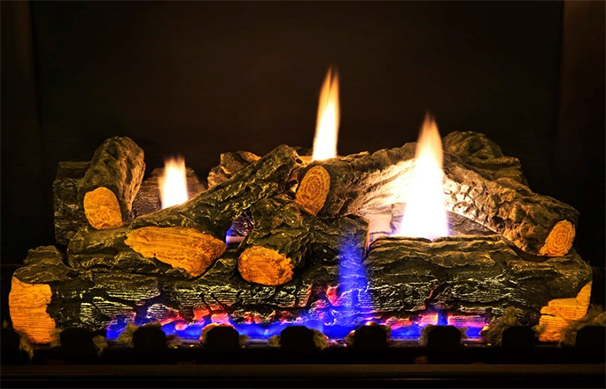You may have heard about “ventless” gas fireplaces – especially if you’re a fan of those home-improvement shows on TV. But what are they and how do they work? And would it be a good choice for your home? Let’s take a look at the facts.
Why Are Ventless Gas Fireplaces Popular?
Ventless gas fireplaces are more or less what their name implies. Instead of channeling unburned vapors through a chimney and out of the house, the fire in the unit is adjusted to burn at maximum efficiency, minimizing the production of harmful carbon monoxide gas produced by burning. The small amount of carbon monoxide that remains is safe to be released inside the house.
Because they don’t require connection to a chimney or flue, ventless fireplaces can be inexpensively installed in almost any room of the house. Typically, they’re freestanding units that can be positioned wherever a gas line can be installed — usually against a wall or inside an existing masonry fireplace. The latest models also feature automatic ignition, a function that eliminates the need for an outside electrical circuit to spark the pilot light — a handy feature should the electricity ever go out.
Not only could you save money on installation costs with a ventless fireplace, you’d probably save money on your gas bill, as well. With a traditional “vented” gas fireplace, a good deal of the heat generated by the fire is lost up the chimney. But the heat generated from a ventless fireplace is released into the room – after all, there’s no place to go but “out.” So a cozy night in front of a ventless fireplace may be even more cozy.
But There Are Some Significant Drawbacks
The biggest drawback to a ventless fireplace is that it may be a health risk. Many people have reported physical symptoms from using unvented fireplaces in their homes, such as headaches, eye irritation, chest congestion and coughing spells. Ventless fireplaces may also aggravate existing respiratory issues, such as asthma, bronchitis, or allergies. Then there’s the question about carbon monoxide. Yes, the levels released are within acceptable levels. But those households with children or pregnant women should exercise additional caution before using them.
Plus, unlike traditional fireplaces, ventless fireplaces give off a characteristic odor: the smell of burning kerosene. And it tends to linger even after the fire has gone out. There’s no way to eliminate the odor short of venting the fireplace.
Then there’s the moisture issue. With vented fireplaces, water vaper is produced (a byproduct of the burn) and channeled through the flue and away from the house. But moisture from a ventless fireplace is released into the house, and the excess vapor could encourage mold or mildew to grow in the home.
Despite their warmth, ventless fireplaces are not meant to be the primary source of heat and shouldn’t be left on for longer than an hour. Leaving them on longer could deplete the oxygen levels in a room (which can be solved by opening a window, but that cools off the room).
Finally, even though a ventless fireplace won’t contribute to buildup in your flue, other gas-burning appliances – such as furnaces and water heaters – will. So your chimney and flue will most likely still require regular inspections and cleaning.
The Bottom Line
If you’re considering adding a fireplace – or another fireplace – the choice is up to you. Consider how the pros and cons work with your needs, do your homework, and shop around to find the fireplace that’s best for you and your home.
If you’ve got questions about fireplaces, we’ve got answers! We offer many fireplace services, including:
- Consultation for upgrades, safe operation, efficiency, or fuel change
- New construction consultation for proper planning of combustion air and chimney physics
- Fireplace updates (includes new glass doors, complete reface, cultured stone veneer, and more)
- Fireplace inserts (gas, wood, and pellet)
- Gas log installation, service, and refurbishing
- Wood fireplace installation
- Direct vent gas fireplace installation
Contact Doctor Flue
Call Us: 1-800-438-3583
Email Us: office@drflue.com
Office Hours: Mon-Fri: 8am-4pm
Connect with Doctor Flue on Social Media
Facebook | Twitter | Google + | YouTube | Pinterest | Houzz

